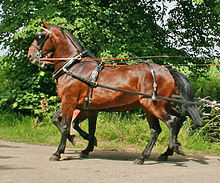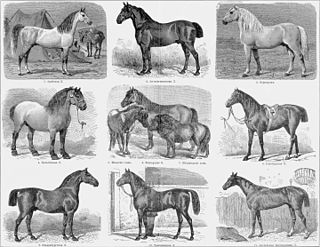
A horse breed is a selectively bred population of domesticated horses, often with pedigrees recorded in a breed registry. However, the term is sometimes used in a broader sense to define landrace animals of a common phenotype located within a limited geographic region, or even feral "breeds" that are naturally selected. Depending on definition, hundreds of "breeds" exist today, developed for many different uses. Horse breeds are loosely divided into three categories based on general temperament: spirited "hot bloods" with speed and endurance; "cold bloods," such as draft horses and some ponies, suitable for slow, heavy work; and "warmbloods," developed from crosses between hot bloods and cold bloods, often focusing on creating breeds for specific riding purposes, particularly in Europe.
Horse breeding is reproduction in horses, and particularly the human-directed process of selective breeding of animals, particularly purebred horses of a given breed. Planned matings can be used to produce specifically desired characteristics in domesticated horses. Furthermore, modern breeding management and technologies can increase the rate of conception, a healthy pregnancy, and successful foaling.

The Arabian or Arab horse is a breed of horse with historic roots on the Arabian Peninsula. With a distinctive head shape and high tail carriage, the Arabian is one of the most easily recognizable horse breeds in the world. It is also one of the oldest modern breeds. Although modern DNA cannot trace breed purity in the modern population beyond 200 years, there is archaeological evidence of horses in the Middle East with landrace characteristics that resemble modern Arabians dating back 3,500 years. Throughout history, Arabian horses have spread around the world by both war and trade, used to improve other breeds by adding speed, refinement, endurance, and strong bone. Today, Arabian bloodlines are found in almost every modern breed of riding horse.

The Percheron is a breed of draft horse that originated in the Huisne river valley in western France, part of the former Perche province, from which the breed takes its name. Usually gray or black in color, Percherons are well-muscled, and known for their intelligence and willingness to work. Although their exact origins are unknown, the ancestors of the breed were present in the valley by the 17th century. They are believed to descend from war horses. Over time, they began to be used for pulling stagecoaches; and later, for agriculture and hauling heavy goods. In the late 18th and early 19th centuries, Arabian blood was added to the breed. Exports of Percherons from France rose exponentially in the late 19th century, and the first purely Percheron stud book was created in France in 1893.

The Selle Français (SF) is a breed of sport horse from France. An athletic horse with good gaits, it is usually bay or chestnut in color. The Selle Français was created in 1958 when several French riding horse breeds were merged into one stud book. The new breed was meant to serve as a unified sport horse during a period when horses were being replaced by mechanization and were transforming into an animal used mainly for sport and leisure.
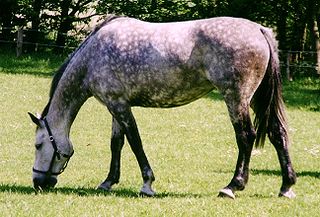
The Holsteiner is a horse breed originating in the Schleswig-Holstein region of northern Germany. It is thought to be the oldest of warmblood breeds, tracing back to the 13th century. Though the population is not large, Holsteiners are a dominant force of international show jumping, and are found at the top levels of dressage, combined driving, show hunters, and eventing.

The Lusitano, also known as the Pure Blood Lusitano or PSL, is a Portuguese horse breed. Horses were known to be present on the Iberian Peninsula as far back as 20,000 BC, and by 800 BC the region was renowned for its war horses. The fame of the horses from Lusitania goes back to the Roman Age, which attributed its speed to the influence of the West wind, who was considered capable of fertilizing the mares. When the Muslims invaded Iberia in 711 AD, they brought Arabian horses with them that were crossed with the native horses, developing a horse that became useful for war, dressage and bull fighting. The Portuguese horse was named the Lusitano, after the word Lusitania, the ancient Roman name for the region that modern Portugal occupies. There are four main breed lineages within the breed today, and characteristics differ slightly between each line.

The Dales Pony is a British breed of pony or small horse. It originated in, and is named for, the Dales of Yorkshire in northern England. It is one the nine native mountain and moorland pony breeds of the United Kingdom, and belongs to the broader Celtic group of ponies which extends from Portugal and northern Spain to Scandinavia.
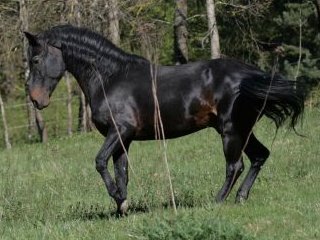
The Kabarda, Kabardin or Circassian horse is a breed from the Caucasus, originating from Eastern Circassia, currently part of the Kabardino-Balkaria region of Russia. These horses are noted for their endurance and ease to adapt in difficult environments.

The Irish Draught horse is the national horse breed of Ireland which developed primarily for farm use. Today, they are especially popular for crossing with Thoroughbreds and warmbloods, producing the popular Irish Sport Horses which excel at the highest levels of eventing and show jumping.
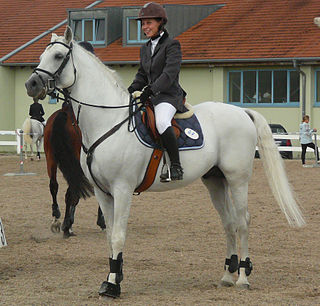
The Shagya Arabian is a horse breed which was developed in the Austro-Hungarian Empire during the 19th century at the Bábolna, Mezőhegyes, Radautz, Piber, and Topolcianky studs. Today it is most often seen in the Czech Republic, Austria, Romania, the former Yugoslavian countries, Poland, Germany, and Hungary, but has been exported to other nations and is bred around the world. A purebred Shagya Arabian today has bloodlines that can be traced in all lines to the stud books of Rădăuți, Babolna, and Topolcianky. The breed is considered by some to be a subtype of Arabian horse, but due to the presence of a small amount of non-Arabian breeding others consider it to be an Anglo-Arabian or a partbred Arabian.

The Jutland horse is a draft horse breed originating in Denmark, named after the Jutland Peninsula which forms the western part of the country. Usually chestnut, they are a compact, muscular breed known for their calm and willing temperament. The breed was originally developed for use in agriculture, but today is more often seen in urban settings and at horse shows. Some of the best known members of the breed pull beer wagons for the Carlsberg brewery around Copenhagen, as well as at competitions and for demonstrations. Images from the 9th century show a horse similar to the Jutland being used by Viking raiders in what is now Great Britain. The first written record is from the 12th century, when they were popular as war horses. Some infusion of bloodlines from other breeds occurred in the 18th century, but the modern Jutland type only began about 1850 with the addition of blood from several other breeds, mainly draft horses. A stud book was created in the late 19th century, and the Jutland population grew to a maximum around 15,000 by 1950. Numbers subsequently declined, and as of 2011, only an estimated 1,000 horses remained.
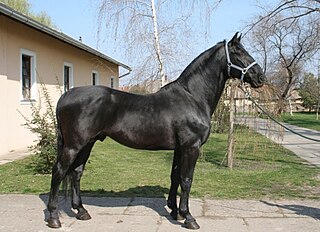
The Nonius is a Hungarian horse breed named after its Anglo-Norman foundation sire. Generally dark in color, it is a muscular and heavy-boned breed, similar in type to other light draft and driving horses. The breed was developed at the Imperial Stud at Mezőhegyes, Hungary by careful linebreeding. Originally bred to serve as a light draft and utility horse for Hungary's military, the breed became a useful agricultural horse during the 20th century. The depredations of World War II significantly reduced the Nonius' population, and in the decades after the war, a downturn in the usage of horses in Hungary sent many members of the breed to slaughter. Today the breed is bred by preservationists and is used in agriculture, leisure riding, and competitive driving sports. The largest numbers of Nonius horses are still found at Mezőhegyes, with representatives in other eastern European nations as well.

The heavy warmbloods are a group of horse breeds primarily from continental Europe. The title includes the Ostfriesen and Alt-Oldenburger ("Old-Oldenburger"), Groningen, and similar horses from Silesia, Saxony-Thuringia, and Bavaria. Breeds like the Hungarian Nonius, Kladruber, and Cleveland Bay are also often classed as "heavy warmbloods." They are the ancestors of the modern warmbloods, and are typically bred by preservation groups to fit the pre-World War I model of the all-purpose utility horse. Unlike the registries of the sport horses that followed them, many heavy warmblood registries maintain closed or partly closed studbooks. However, external evaluation and performance testing of the breeding stock is still a key element in these registries. Many of the heavy warmbloods are selected primarily for family-friendly temperaments.

The Marbach Stud, German: Haupt- und Landgestüt Marbach, is Germany's oldest state stud farm for horse breeding, has a history that dates back over 500 years. It is located in southwest Germany near Gomadingen in the Reutlingen district of Baden-Württemberg. The annual stallion parade is an internationally known attraction, and the stud hosts over 500,000 visitors per year. The stud also offers courses for those wishing to learn to ride or drive, as well as an instructor training program. Marbach is known for producing athletic horses with good temperaments, and has careful management practices, including that of allowing young, untrained horses the opportunity to grow in a natural setting conducive to their mental as well as their physical development.

The Alt-Oldenburger and Ostfriesen are representatives of a group of horse breeds primarily from continental Europe called heavy warmbloods. The breed has two names because the same horse was bred in two regions in the most north-western part of Germany: East Frisia and the former grand duchy of Oldenburg. The name "Alt-Oldenburger" – alt meaning "old" – simply distinguishes this horse from its descendant, the modern Oldenburg, which is bred for sport.
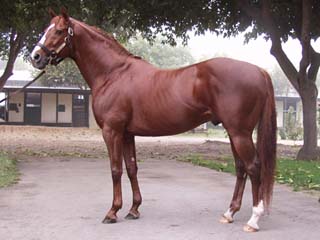
The Thoroughbred is a horse breed developed for horse racing. Although the word thoroughbred is sometimes used to refer to any breed of purebred horse, it technically refers only to the Thoroughbred breed. Thoroughbreds are considered "hot-blooded" horses that are known for their agility, speed, and spirit.
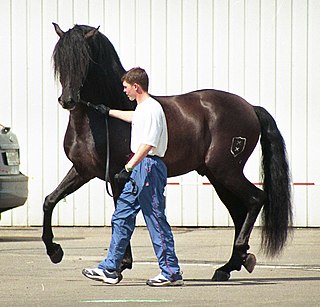
The Andalusian, also known as the Pure Spanish Horse or PRE, is a horse breed from the Iberian Peninsula, where its ancestors have lived for thousands of years. The Andalusian has been recognized as a distinct breed since the 15th century, and its conformation has changed very little over the centuries. Throughout its history, it has been known for its prowess as a war horse, and was prized by the nobility. The breed was used as a tool of diplomacy by the Spanish government, and kings across Europe rode and owned Spanish horses. During the 19th century, warfare, disease and crossbreeding reduced herd numbers dramatically, and despite some recovery in the late 19th century, the trend continued into the early 20th century. Exports of Andalusians from Spain were restricted until the 1960s, but the breed has since spread throughout the world, despite their low population. In 2010, there were more than 185,000 registered Andalusians worldwide.
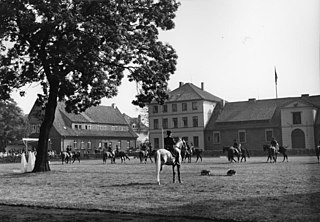
Celle State Stud is a state-owned facility for horse breeding in Celle, Germany. The State Stud of Celle, located in what is now known as Lower Saxony, was founded in 1735 by order of George II, King of Great Britain, Elector of Hanover and Duke of Brunswick-Lüneburg. Its purpose was to make high-quality stallions available to local breeders. Several wars affected not only the safety of the horses, but the types of stallions housed there. Celle's history is intertwined with the history of the Hanoverian horse breed, but the breed registry is privately owned and is an entity independent of the stud. Today the state stud is known for its annual stallion parades.

The Norman Cob or Cob Normand is a breed of light draught horse that originated in the region of Normandy in northern France. It is of medium size, with a range of heights and weights, due to selective breeding for a wide range of uses. Its conformation is similar to a robust Thoroughbred, and it more closely resembles a Thoroughbred cross than other French draught breeds. The breed is known for its lively, long-striding trot. Common colours include chestnut, bay and seal brown. There are three general subsets within the breed: horses used under saddle, those used in harness, and those destined for meat production. It is popular for recreational and competitive driving, representing France internationally in the latter, and is also used for several riding disciplines.


